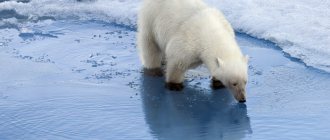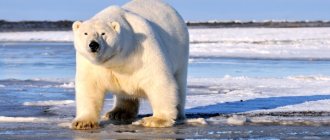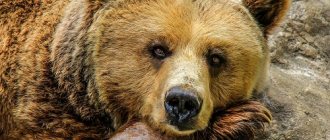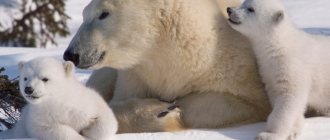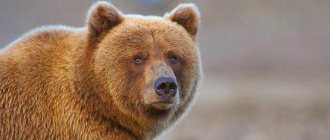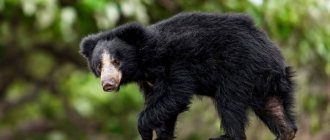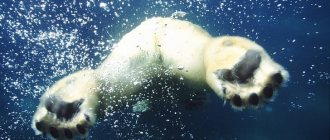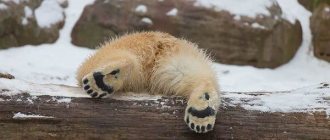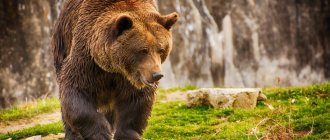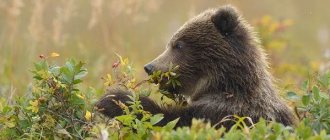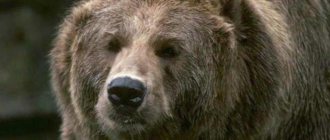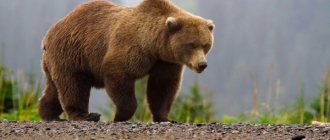27 May54311bear familypredatorlarge dangerous
The polar bear (other names for the polar bear: polar bear, northern bear, oshkuy, nanuk, umka, sea bear) is one of the largest predators on the planet, which is a member of the Bear family. The big polar bear is the embodiment of strength. Since ancient times, the polar polar bear has become a respected character in folklore among the indigenous northern peoples. In this article you can see a photo and description of a polar bear, learn a lot of new and interesting things about this large and strong predator of the North.
Appearance
Appearance of a polar bear
Appearance of a polar bear
Appearance of a polar bear
Appearance of a polar bear
Appearance of a polar bear
The polar bear's head is narrow, extended forward, and the head is supported by a long neck. The animal's ears stick out upward and have a round shape. The color of the individuals is white, without any spots. The skin under the fur is black. The paws have dense pads covered with hair and growths that prevent them from sliding on ice. There are membranes between the toes that allow the animal to swim quickly.
Living in a polar climate, the animal does not feel the cold thanks to its thick coat, which grows in two layers. There is also a layer of fat under the skin, the thickness of which can be 13 cm.
The polar bear's body is massive and round in shape. The limbs are long, thanks to which the predator can reach prey without getting close to it.
Lifestyle
Due to changes in the ice territory throughout the year, bears have to migrate. In summer they move towards the pole, and in winter they move south, closer to the mainland.
In the cold season, animals climb into dens, which are located near the sea line. Female bears spend up to two and a half months in dens. Males and representatives of the younger generation do not hibernate for long.Representatives of this species are distinguished by their speed, ability to swim and dive well. Although outwardly they may seem clumsy, but in reality this is not at all the case. Thanks to the thick and dense coat, as well as a layer of subcutaneous fat reaching 8-10 cm, the animal does not freeze even in icy water. The coat color helps to camouflage among the snow-white plains.
Dimensions
Comparison of the sizes of different types of bears
The polar bear is one of the largest predators on the planet. The length of its body can be 3 m, and the weight with such dimensions is in the region of a ton. Adults reach a height of up to 1.5 m.
Males are larger than females, and in most cases they grow up to 2.4 m in length and weigh 400 kg. Females stretch up to 2 m, and their weight is 300 kg.
Family ties
Bears first appeared on the planet about 5 million years ago. The polar bear separated from its brown ancestors no more than 600 thousand years ago, and yet its closest relative continues to be the ordinary brown bear.
Both the polar bear and the brown bear are genetically similar, therefore, as a result of crossing, completely viable offspring are obtained, which can subsequently also be used to produce young animals. Black and white bears will not naturally be born, but the young will inherit all the best qualities of both individuals.
At the same time, polar and brown bears live in different ecological systems, which affected the development of a number of phenotypic characteristics in them, as well as differences in nutrition, behavior and lifestyle. The presence of significant differences in all of the above allowed us to classify the brown bear, or grizzly, as a separate species.
Characteristics
Polar bear during a jump
The polar bear has a number of characteristics that make it an excellent predator:
- excellent sense of smell allows you to smell a scent at a distance of up to 1.6 km;
- thanks to good vision, the predator clearly sees objects located a kilometer away from it;
- the ears of a polar bear are able to hear sounds even under a thick layer of ice;
- the maximum speed of the animal is 40 km/h;
- The polar bear has great endurance, thanks to which it can be on the road for a long time and walk 5-7 km per hour without slowing down;
- the predator is capable of swimming at a speed of 10 km/h.
The animal can also move through water for a long time. The record belongs to a polar bear who swam for 9 days without stopping and covered a distance of 687 km.
Why do you dream about a polar bear?
It would be strange if, while respecting the polar bear so much, we did not attach importance to its appearance in our dreams. Not at all. In almost all known dream books you can read why a polar bear dreams. Some consider his appearance in a dream to be positive and bode well, while others advise preparing for troubles after this.
For example, Miller’s dream book says that a polar bear in a dream means an upcoming serious life choice. If a bear attacks in a dream, beware of enemies in life. A bear floating on an ice floe will warn you about fraud.
And seeing a bear eating a seal means that you need to give up bad habits. If you bask on the skin of a polar bear, you will easily overcome troubles in reality. If you see a polar bear, it means you can expect a wedding and financial gain soon.
According to Freud, hunting a polar bear in a dream means that you need to reduce aggression and unnecessary ardor in your life. And according to Aesop, a predator dreams of both good and cruelty. You cannot fight with him in a dream, otherwise failure will befall you in reality. However, if you pretend to be dead when you meet him, you will easily get out of unpleasant problems in reality.
A sleeping polar bear means that your problems may leave you alone for a while. In any case, it is very good if our bear is dreamed of by that person who thinks about his safe future existence and can help him survive.
Habitat – where do polar bears live?
Habitat of the polar bear
The polar bear lives in the polar territories of the northern hemisphere. The southern border of its range runs through the island of Newfoundland. The predator is also found in tundra lands belonging to Russia, the USA, Canada and Greenland. Polar bears live off the coast of the Chukchi, Barents, and Kara seas.
Interesting: The Black Book is extinct animals. What is it, list with photos, reasons for disappearance, video
Some individuals live in the Arctic, but generally prefer not to leave the southern regions of this area. Their home territories also depend on the polar ice boundary. In the summer they melt, and animals are forced to move to colder areas.
Interesting fact : polar bears do not live beyond 88 degrees north latitude. This is due to the fact that the climate here is too cold. Temperatures can drop below – 50 degrees Celsius.
Why is a polar bear white, or what does a polar bear look like?
The polar bear looks very large and is one of the largest animals in the world. In addition, the polar bear is a predator. The great polar bear looks huge, because it can reach 3 meters in length, while the weight of a polar bear can be as much as a ton. The mass of a polar bear is one of the main components of its impressive size. But such large polar bears are not common.
On average, a male polar bear weighs 450 kg and has a body length of 2-2.5 meters. Females are much smaller. A female polar bear weighs up to 300 kg and her body length is 2 meters. The height of a polar bear at the withers varies from 130 to 150 cm. It is curious that the smallest polar bears are found in Spitsbergen, and the largest polar bears live in the Bering Sea.
The polar bear differs from other bears primarily in that it is white. Why is a polar bear white? Everything is simple here - it is determined by the polar bear’s habitat. Indeed, in conditions of permafrost and snow-white horizons, the polar bear has the opportunity to remain unnoticed. This is why the polar bear is white.
The polar bear looks slightly different than other members of the Bear family. But it is not only the color that distinguishes the polar bear from other members of the family. Also distinguishing the Arctic polar bear is its long neck and flat head shape.
Surprisingly, the skin of the northern polar bear is black, and its nose and lips are the same color. The color of a polar bear's fur varies from completely white to white with a yellowish tint. In summer, the polar bear's fur completely turns yellow under constant exposure to sunlight. This animal has small ears and a short tail, which is completely invisible under a thick snow-white fur coat.
The polar bear's fur is very thick, with dense undercoat and quite coarse. The polar bear's thick fur retains heat and protects its body from getting wet. It is not only thanks to its warm fur that the polar bear does not freeze. Under the skin it has a layer of fat, the thickness of which is about 10 cm. This fat layer allows it to not freeze even in the most severe frosts and when in cold water.
The polar bear's fur has no pigment, and its hairs are empty inside. Due to this structure of the hairs, a polar bear can sometimes turn green. This happens in a climate that is unusual for polar bears to live in. When kept in zoos, algae grow inside the bear's fur, which gives it a greenish tint.
The polar bear looks massive. Nature provided this northern beast with everything necessary for life in the coldest parts of the globe in order to be a perfect predator. The northern polar bear has a warm fur coat and fur on the soles of its paws, which allows it not to slip on ice and not freeze. It even has a membrane between its toes, which makes the polar bear a good swimmer. The polar bear's skin has a thick layer of subcutaneous fat to keep it from freezing in icy water. The large polar bear also has large claws and impressive fangs, which allow it to cope with even strong prey.
Character traits
Young cubs often play with each other.
The polar bear, despite its predatory lifestyle, is a rather calm animal. He only shows aggression in situations where it is necessary. The animal is also capable of showing excellent endurance and patience. Sometimes he can sit in one place for hours and watch for prey before revealing himself and starting pursuit.
Young individuals often play with each other, starting fights. During them, they do not cause any harm to the enemy, but they learn to fight. This allows you to acquire skills that will be useful in hunting in the future.
Interesting fact : females take an active part in the games of the cubs, looking after them and helping them learn the basics of survival.
Hunting
The bear tracks its prey for a long time; sometimes it stands for hours near the hole, waiting for the seal to come up for air. As soon as the prey's head is above the water, the predator strikes it with a powerful paw. He grabs the stunned carcass with his claws and drags him to land. To increase its chances of being caught, the bear expands the boundaries of the hole and practically immerses its head in the water in order to have time to notice the appearance of prey.
Seals cannot spend all their time in the water; they need to rest sometimes, which is what polar bears take advantage of. Having noticed a suitable seal, the bear quietly swims up and turns over the ice floe on which it is resting. The seal's fate is sealed. If a walrus became the bear's prey, then everything is not so simple. Walruses have powerful defenses in the form of their front tusks, with which they can easily pierce an unlucky attacker. An adult walrus can be much stronger than a bear, especially if it is young and does not yet have sufficient experience in such battles.
With this in mind, bears attack only weak or young walruses, doing this exclusively on land. The prey is tracked for a long time, the bear creeps up to the closest possible distance, after which it makes a jump and leans on the victim with all its weight.
What does it eat?
Since the polar bear leads a predatory lifestyle, it eats only meat. It mainly hunts walrus, seal, seal, hare, narwhal and beluga whale. After the animal catches its prey, it butchers it with its paws and teeth.
The bear eats the fat and skin of a captured animal. He eats meat only in extreme cases, when he is very hungry. From food, the predator obtains vitamin A, which is involved in the formation of proteins and fat deposits. This allows the bear to maintain a supply of resources in its body necessary to survive in a cold climate.
Every day an adult eats an average of 7 kg of food. If a predator has been hungry for a long time, it can consume up to 20 kg per day. An animal that has not eaten for several days stops hunting its usual prey because it feels weak. Then he switches to fishing, destroying bird nests and carrion.
The hungry period for polar bears begins in the summer, when the ice melts. Because of this, they are forced to move to colder areas, where the amount of food is much less. Under such conditions, the bear sometimes starves for 2-3 months, using up the body’s internal resources. In this state, he attacks everything that moves, just to eat.
Nutrition
The polar bear is an animal born for hunting. Everything is beneficial - webbed feet for swimming, a good sense of smell, sharp eyesight, and excellent hearing. He runs, jumps, swims, camouflages. His status as a hunter is unsurpassed in the North.
Any creature in sight can become its prey. It hunts on land and in water, eating meat and fish. Favorite prey is seal and bearded seal. He is able to smell them through the thickness of the ice, and then patiently watch over the hole. Or attack right in the water. It kills the prey, then begins to consume the skin and fat. This is the preferred body part of prey.
They practically do not eat fresh meat, making preparations for the hungry period. This menu helps them accumulate vitamin A to survive the cold and winter. The hunter's victims can be seals, young walruses, beluga whales, narwhals, and fish. On land, he is able to catch reindeer, wolves, and arctic foxes.
Sometimes, under the spring snow, they dig up roots to diversify their protein food. To get enough, he needs up to 7 kg of food. And a hungry predator may need more than 15 kg.
If the victim managed to escape from him, and he has no strength left for a new hunt, then the food is fish, carrion, bird eggs, and chicks. It is at the moment of forced hunger strike that he becomes especially dangerous. It can wander to the outskirts of human settlements, climb into garbage garbage and even attack a person.
He does not neglect algae and grass, quickly using up fat deposits. These are mainly the summer months, about 120 days. What the animal eats at this time cannot be classified at all. He eats almost everything.
In nature, an animal has few enemies. Only adult walruses are able to repel him with their tusks. And small bear cubs can be harmed by a pack of wolves or dogs. The main danger for him was and remains man. Poachers kill it for its luxurious skin and large amounts of meat.
How to hunt
Polar bear on the hunt
Polar bears use different hunting methods that will be most effective in capturing a particular animal. For example, in order to grab a hare, they may hide in tall grass and wait for it to approach. As soon as the animal is nearby, the predator stuns it with a powerful blow of its paw.
If a bear discovers a walrus on a drifting ice floe, it can swim up unnoticed and turn it over. Due to the effect of surprise, the animal gets lost in space and becomes easy prey. However, bears often do not dare to attack walruses while they are on a hard surface, because they are afraid of running into long tusks.
Interesting: Animals - species, list, names, description, where they live, photos and videos
To catch a seal, the predator looks for holes in the ice left by potential prey. The bear breaks them at the edges in order to fit inside, sinks under the water up to the waist and grabs the animal with its mouth, after which it pulls it out.
Interesting fact : polar bears can sneak up on prey unnoticed, quickly reducing the distance to 10-12 m, after which they make a dash and attack the target.
What does a polar bear eat and how does it hunt?
Unlike such a representative of the Ursidae as the giant panda, the polar bear is a predator. In addition, the northern polar bear is the only one of the largest land predators on the planet that is prone to tracking and hunting humans, considering them to be equal prey. It is not for nothing that the polar bear is one of the most dangerous animals in the world.
The polar bear is the king of the north, because it is at the top of the food chain in the Arctic. Often in children's books, polar bears are depicted in the company of penguins. This may mislead them into thinking they live at the same pole. But this is not so, because the polar bear lives at the North Pole in the Arctic, and penguins live in Antarctica at the South Pole. Therefore, the answer to the question why polar bears do not eat penguins is very simple - they live at different poles.
The polar bear lives on drifting and multi-year sea ice, where it can freely hunt prey. The polar bear feeds on ringed seals, seals, walruses and other marine animals. He sneaks up on them from behind shelters or lies in wait near the holes. As soon as the animal appears, the bear delivers a stunning blow to the victim with one paw. During a hunt, a polar bear can turn over an ice floe on which there are seals. However, an Arctic polar bear can only defeat a walrus on land.
The polar bear feeds by eating primarily the skin and lard. He can eat a whole carcass only as a last resort and when very hungry. Usually the leftovers are eaten by arctic foxes. The polar bear also feeds by picking up carrion, dead fish, bird eggs and chicks. Sometimes polar bears eat grass and seaweed, and in residential areas they happily feast on garbage dumps. The polar polar bear is even capable of robbing the food warehouse of polar expeditions.
Despite the fact that the big polar bear seems clumsy, it is very fast and agile on land, and also swims and dives in water with ease. On land, a polar bear moves at an average speed of 5.5 km/h, and when running it can reach speeds of up to 40 km/h. In one day, a polar bear can cover a distance of up to 20 km on land. In water, a polar bear can swim without stopping for several days, covering up to 160 km per day, while its speed reaches up to 6.5 km/h. This animal swims and dives very well, and an Arctic polar bear can stay under water for up to 2 minutes.
The polar bear's fur protects its body from getting wet in icy water, and a 10 cm thick layer of subcutaneous fat provides excellent protection from the cold. The white color perfectly camouflages the predator. Polar polar bears have very well developed senses. Excellent hearing, smell and vision easily help the great polar bear to notice prey at a distance of several kilometers. Even under a meter-long layer of snow, the polar polar bear senses prey and can detect the slightest movement while being above the shelter of a potential victim.
It is better not to come face to face with this predator. After all, a polar bear can track and hunt humans. Repeated cases of polar bear attacks on humans are described in the reports of polar travelers. In places where there is a risk of encountering this animal, you must move carefully.
In populated areas where this predator may appear nearby, you should make sure that it does not have free access to garbage dumps, which are very attractive to curious bears. The Canadian province of Manitoba is home to many polar bears. The city of Churchill even has a special prison for temporary detention of bears that get too close to the city. Such measures ensure the safety of residents.
Hibernation
Polar bear with cubs
In winter, pregnant females hibernate, which lasts 50-80 days. Males and females who are not expecting offspring can also wait out the frosts in this way. However, their hibernation lasts 5-7 days, and does not occur every year.
Before falling asleep, the bear digs a den or occupies a ready-made one. Most pregnant females go to Wrangel Island and the Franz Josef Archipelago, where they hibernate.
Lifestyle and habitat
Polar bears live in the polar regions of the planet's northern hemisphere. He is an inhabitant of the Northern icy latitudes. In Russia, it can be seen on the Arctic coast of Chukotka, in the gulf of the Chukchi and Bering seas.
Its Chukotka population is now considered the largest on earth. According to research, the largest representatives live in the Barents Sea, while smaller individuals live near the island of Spitsbergen. To forestall possible questions, we inform you that there are no polar bears in Antarctica. His homeland is the Arctic.
The northern owner inhabits places close to water. Can swim on drifting and fast sea ice. It makes seasonal migrations along with changes in the boundaries of polar ice: in the summer it moves with them closer to the pole, in the winter it returns to the mainland. For the winter it lies in a den on land.
Females usually go into hibernation while awaiting the birth of cubs. During this period, they try not to move so as not to harm future offspring. Hence hibernation. It lasts 80-90 days. Males and other females who are not expecting offspring can also sometimes hibernate, but not for long and not every year.
The bear is an excellent swimmer, and its thick, dense fur perfectly protects it from cold water. A thick layer of subcutaneous fat also helps protect against cold. The animal easily hides in ice and snow, senses prey several kilometers away, and is almost impossible to escape or swim away from.
Early polar explorers repeatedly frightened with tales of the ferocity of this beast. They said that he did not hesitate to penetrate ships frozen in ice in order to obtain food.
A whole group of them ruled the deck, absolutely not afraid of the sailors. They repeatedly attacked wintering quarters, destroyed travelers' huts, and broke the roof, trying to break through.
However, later stories of polar explorers made much more modest mention of the ferocity of this beast. Even without a weapon, it was enough for a person to shout loudly to scare the animal and cause it to flee. The quiet silence of the ice taught him to be afraid of loud sounds.
A wounded animal always runs away. He hides in the snow to heal. However, if a person decides to attack cubs or enter the beast’s lair, he becomes a serious adversary. Then even a firearm cannot stop him.
He is cautious and curious, but not cowardly. They say that when people came across a polar bear, they fled for their lives. And then the predator began to chase them. Along the way they threw their things - hats, gloves, sticks, something else.
The beast stopped every time and methodically sniffed the finds, examining each item with curiosity. It was not clear whether the bear was chasing people or was interested in their household items. As a result, it was thanks to the curiosity of the predator that people managed to escape from it.
Usually bears live alone, without creating large family groups. Although, when forced to gather, hierarchy and discipline are established between them. The largest predator is always the most important. Although they are quite loyal to each other. Only for small bear cubs can adult bears sometimes become dangerous.
Polar bears caught in their youth can live successfully in captivity and become accustomed to people. They require frequent bathing; it is even better for them to wallow in the snow. Regarding food, there is little trouble with them, since they eat everything - meat, fish, and honey. They are quite unfriendly with other bears in captivity. In old age they become very irritable. There are cases where they lived up to 25-30 years and even reproduced.
Reproduction
A female bear gives birth to her first offspring no earlier than four years of age. Cubs appear at intervals of 2-3 years. At one time, the female gives birth to no more than three cubs. The mating season for polar bears begins in March and lasts until June. One female is usually claimed by at least three males, who fight each other for her attention. Having assessed everyone's signs of attention, the female chooses the most suitable one.
Preparations for childbirth begin in October. The bear finds a suitable place and digs a den. She goes into hibernation in mid-November and stays there until about April.
Interesting fact : pregnant bears often gather in groups and dig dens in the same areas, helping each other.
White bear cub
Pregnancy lasts 250 days. Bear cubs are born blind and deaf. The first month they are defenseless, and only after 30 days they open their eyes. Newborn cubs weigh on average 600 grams, and their size does not exceed 35 cm. Over the course of 90 days, the cubs gain weight and become accustomed to the outside world, after which they begin to leave the den with their mother. The offspring live with a female bear for 2-3 years, and for the first 18 months they feed only on milk.
Social structure and reproduction
Photo: Polar bear cubs
Polar bears are loners by nature, both males and females. They may roam and hunt close to each other, but do not interact much. When the mating season begins for animals, which is spring, March - June, males can follow females and engage in fights with other males. Each mature female may be accompanied by several mature males. She mates with one, the winner.
Pregnancy lasts about eight months. During this time, the females manage to organize a den for themselves and hibernate. By spring, from one to three cubs are born, but most often there are two. The weight of one baby is less than a kilogram, and there is no hair. In twenty percent of cases, babies die. Until a month old, the cubs are completely blind, they develop very slowly and need maternal warmth and care. The lactation period for polar bears lasts up to one and a half years. Even up to two years old, the cubs can remain with their mother, then they begin to lead a solitary life.
Females become sexually mature at four years of age, but sometimes they can give birth to their first offspring as early as eight years of age. Males reach maturity at around five years of age or even later. A mother bear devotes a total of three years to pregnancy and breastfeeding. This is the most successful option when females give birth once every three years. But in nature, of course, difficulties regularly occur and females become pregnant less often. Therefore, it is quite difficult to increase the number of polar bears.
Natural enemies
Since the polar bear is one of the most powerful and ferocious predators, in natural conditions it has practically no enemies. An adult and healthy individual is not afraid of other animals, since it can easily cope with even a group of attackers.
Interesting: Caracal - description, nutrition, lifestyle, enemies, photos and videos
During a fight, polar bears often stand on their hind legs
If a polar bear is sick or weak from hunger, it can be attacked by wolves, arctic foxes, walruses and killer whales. In such a situation, the beast will retreat, evenly fighting off the advancing opponents. Also, a vulnerable bear tries not to stray far from its den. And if he manages to hide in the “house”, the attackers will not have the opportunity to win. Having climbed inside, the bear will turn its head towards the entrance and will be ready to repel any predator.
Diet
Polar bears see and hear very well, and also have a sensitive sense of smell, so they can easily sense prey, even if it is several kilometers away.
The nutrition of an animal depends on its characteristics, as well as on its environment and habitat. Individuals of this species live in harsh polar winter conditions and are well adapted to this. They are very good swimmers and can stay in cold water for a long time.
For these reasons, the objects of their hunt are often marine life, such as walruses or sea urchins. Their diet also includes chicks, eggs, young and defenseless animals, as well as carcasses of animals and fish washed ashore.If there is enough food, then the animals do not eat everything. First of all, they will prefer to eat the subcutaneous fat and skin of seals and walruses. If there is absolutely not enough food, then the predator can eat the corpses of other bears, even its own cubs.
It is extremely rare for predators to feed on berries and vegetation. Climate change has greatly affected the diet of these animals. For this reason, animals began to get food on land to a greater extent than in the sea.
- Detailed description with photos of all animals included in the Red Book of Russia
Zebra - habitats, appearance, diet and behavior, life cycle + 94 photos
- Leopard - habitats, life cycle, rutting season and lifespan + 118 photos
Why is the species declining in number?
The number of polar bears is gradually declining, and some populations may disappear completely in the coming years. It is believed that in 40 years only a third of the current number of individuals will live on Earth.
The main reason why the number of polar bears is gradually declining is the gradual melting of ice due to global warming. The animal's habitat is shrinking, it is more difficult for it to find food, and pregnant bears do not always have time to get to favorable places for childbirth. Early thaws also destroy dens where females and offspring are located at that time. This leads to their disappearance.
Ice in areas where bears live is gradually melting due to climate change
Humans also make their “contribution” to the reduction in the number of polar bears. By poaching, hunters obtain skins that are highly valued on the black market.
Interesting fact : hunting polar bears in the USSR was banned in 1956, but poachers did not stop their activities.
Every year on the territory of the Russian Federation, poachers harvest an average of 150 skins. And in Canada this number is around 1000.
Ecological deterioration also negatively affects the number of polar bears. Continuous oil production and transportation contribute to the appearance of an oil film on the sea surface. Because of this, the ecology is disrupted and population numbers are declining. If an oil film gets on a bear's fur, its thermoregulation is disrupted. Because of this, the animal begins to freeze. Oil often penetrates into the predator’s body along with food obtained in the water. This leads to poisoning.
Unique facts about the polar bear
The polar bear has won the attention of people who have created a large number of legends and stories about it. Here are reliable facts about this polar animal that will surely interest many lovers of Arctic polar nature:
- A population of small individuals has been recorded on the island of Spitsbergen and areas nearby, while larger animals have chosen the Barents Sea.
- If you take photographs under UV lighting, the polar bear will turn into a “black” one.
- Hunger forces bears to travel vast distances on land and in water. This is their similarity with their brown counterparts. A case was recorded when a polar bear swam in the Beaufort Sea, which lasted more than 9 days without stopping. The female traveled 660 km, losing 22% of her body weight and her cub. She herself survived and made her way ashore on her own.
- The Arctic bear is fearless, capable of attacking a person, making him its prey. If hunger forces him, it will haunt him for several days. In the province of Manitoba, the city of Churchill in Canada, there is a special shelter for bears that have strayed into the settlement. They are placed there for a while, this is a necessary measure. A predator can easily enter a people’s home, driven by severe hunger. After it is fed and allowed to rest, the animal is released and it leaves the person’s place of residence. This approach gives hope that the predator will not return to them soon.
- Eskimos believe that the white resident of the Arctic is the embodiment of the power of nature. A man can earn this right by defeating a bear in a fair fight.
- Previously existing giant polar bears are the ancestors of the modern representative of the Arctic.
- The bear, weighing just over a ton, was shot and killed in Alaska in 1962.
- The polar bear is a warm-blooded animal. His body temperature is about 30C. This prevents him from moving quickly. Running for long periods of time can cause your body to overheat.
- Children usually receive their first knowledge about the existence of polar bears after watching cartoons such as “Umka”, “Elka” and “Bernard”.
- The image of this animal is present on the wrappers of the “Bear in the North” sweets.
- February 27th became the official polar bear day.
- The polar bear is the symbol of Alaska.
Unique facts about the polar bear
Population and species status
The polar bear is listed in the Red Book of the countries where it lives. To maintain the population size, a reserve was created on Wrangel Island in 1976, where local individuals are cared for. People monitor the preservation of dens and maintain suitable environmental conditions.
In 2008, a special program was launched in Russia aimed at preserving and maintaining the number of polar bears. In the Russian Federation, it is estimated that approximately 5 thousand individuals live, and in the world their number ranges from 20 to 25 thousand.
Classification
Despite the genetic similarity of brown and polar bears, according to all evaluation criteria, they belong to different taxa. Various ecological niches, morphological characters, food preferences and behavioral characteristics made it possible to classify them into two independent species in the taxonomy.
Some confusion arose with the classification of the animal. Initially it was considered a land mammal. When it was established that there were membranes between the predator’s fingers, and that it spent a significant part of its time in the water, it was classified as a marine animal.
Scientific classification
- Domain: eukaryotes
- Kingdom: Animals
- Subkingdom: eumetazoans
- No rank: bilaterally symmetrical
- No rank: deuterostomes
- Type: chordates
- Subphylum: vertebrates
- Infratype: gnathostomes
- Superclass: quadrupeds
- Class: mammals
- Subclass: animals
- Infraclass: placental
- Superorder: Laurasiotherium
- Order: carnivores
- Suborder: Caniformes
- Family: bears
- Genus: bears
- Species: polar bear
Origin of the species and description
Photo: Polar bear
According to recent studies, scientists have concluded that the polar bear as a species appeared quite recently through rapid evolution. The age of the species is estimated at only 150 thousand years. Although you cannot completely rely on this information, collecting the genetic material of a given animal has its own difficulties. It is very rare to find remains in the ice; perhaps much about these animals is still preserved there.
So, the polar bear belongs to the class of mammals, order of predators, suborder of canids, family of bears, genus of bears. It is also called a polar bear, less often a northern or sea bear. It is believed that polar bears evolved from brown bears during evolution and adaptation to the northern polar latitudes.
Video: Polar bear
Already in this century, evidence of the existence of an intermediate species was discovered - a giant polar bear, its bones are one and a half times larger than those of a modern one, the finds are limited to a few bones. The DNA of this species is similar to that of both the brown bear and the modern white bear. Therefore, it can be considered an intermediate link in evolution.
The diversity of species during evolution is excluded; animals are very limited by living conditions and type of nutrition. This is one of the most powerful and dangerous predators. Its body is very massive: it reaches 3 meters in length and up to 1.5 meters at the withers. The weight of such an animal is very large: for the largest males it is 800 - 1000 kg, females are much smaller and the largest of them weigh almost 400 kg.
Other large bears
In addition to the white one, the bear family also includes other large species. They are slightly inferior in size to their polar counterpart.
Brown bear
The polar bear's rather large cousin is the brown bear. In different countries, the brown bear is known by the subspecies that lives in the region:
- the European brown bear lives in Eurasia;
- Tien Shan brown bear - in Central Asia;
- Siberian brown bear - in Siberia, China;
- grizzly bear settled in North America;
- Kodiak - on the island of the same name off the coast of Alaska.
Brown bear: Unsplash
The brown bear of the Kodiak subspecies can reach 2.8 meters in length, and the weight of the heaviest Kodiak was almost 800 kg.
All subspecies of brown bear have an average portrait:
- dark shade of fur;
- powerful body and five-fingered paws;
- small ears and eyes;
- small tail.
Animals prefer forests as a habitat. European bears - mountain forests. Brown bears are omnivores. The basis of their diet is plant foods:
- berries;
- nuts;
- acorns;
- tubers.
Important components of the diet of brown bears are insects, larvae, small animals and fish. Bears also love honey, and their bodies are resistant to bee stings.
Brown bears have virtually no natural enemies in the wild. Only tigers in certain regions of Asia can compete with them. Often, taking advantage of their impressive size, brown bears take prey from other predators.
This species has a pronounced seasonal activity. By winter, the bear gains fat and digs a den. Hibernation can last up to six months.
The brown bear is no less important a heraldic symbol than the white one. The bear can be found on the coats of arms of such large cities:
- Berlin, Germany);
- Madrid, Spain);
- Bruges (Belgium);
- Yaroslavl and Veliky Novgorod (RF).
Video
And in conclusion, an interesting documentary about brown bears.
Author: Pavel Chaika, editor-in-chief of Poznavaika magazine
When writing the article, I tried to make it as interesting, useful and high-quality as possible. I would be grateful for any feedback and constructive criticism in the form of comments on the article. You can also write your wish/question/suggestion to my email [email protected] or Facebook, with respect, the author.
Author page
Hibernation
A bear is preparing to hibernate in a den. In
the fall, bears, sensing the approach of cold weather, begin to eat everything they encounter on their way. This is necessary in order to gain as much weight as possible, due to which they can survive during hibernation. Some bears eat up to 200 kg before entering suspended animation.
Active weight gain is not done by chance, and any individual tries to eat more than necessary. After all, if the body’s reserves are not enough for the entire winter period, the bear will wake up ahead of time. He will have no choice but to leave the den and go in search of food. But when everything is covered with snow, it is quite difficult for the animal to quickly adapt and provide itself with everything it needs. Moreover, some bears that do not accumulate enough reserves may not hibernate at all. Then they will have to survive from the first day of winter, and often they will not succeed.
Interesting fact : bears that do not hibernate or come out of hibernation prematurely are called cranks. They are very aggressive, hungry and attack anything that moves.
Hibernation for a bear lasts approximately 200 days. During this period, the animal is in a state of suspended animation. He doesn't move, doesn't eat, just sleeps. At the same time, the processes in his body slow down by 55%. Heart rate drops to 8 beats per minute, instead of the usual 50-55. The animal can remain in this state until the body’s internal resources run out.
The bear winters in its own den, having previously prepared it. Thanks to its thick fur, it does not need to additionally insulate its home during cold weather. He simply cleans out everything unnecessary from it and disguises the entrance a little to protect himself from unwanted guests. Although who wants to wake up a potential connecting rod bear?
Polar bear lifestyle
Polar bears lead a predominantly solitary lifestyle; They stay in pairs only during the rutting season. Cases of their accumulation, sometimes up to several dozen individuals, in places where there is a sufficiently large amount of food, are quite rare. Groups of polar predators are quite tolerant of each other’s company even when feeding on large prey, such as a dead whale. However, ritual battles or games are not uncommon, but each animal does not forget about its hierarchical status.
Animals lead a predominantly nomadic lifestyle, with the exception of the time spent in dens. Dens are primarily used by females to give birth and raise their young. It is also a refuge for winter sleep, but animals hibernate for a short time and not every year.
How are dens arranged?
Dens of breeding females can be divided into generic and temporary. At birth, female bears give birth to offspring. Their stay in such dens averages 6 months. A temporary den serves breeding females for a short time - from 1 day to 2-3 weeks, and in isolated cases up to 1 month or more.
The birth den consists of one or more chambers. The length of the chamber is on average from 100 to 500 cm, width - from 70 to 400 cm, height - from 30 to 190 cm, the length of the corridor varies from 15 to 820 cm. The entrance hole is often poorly visible from a distance of several meters.
Why penguins don't live in the Arctic
Penguins evolved somewhat differently. They originally lived in the territory of modern Antarctica and adjacent areas. True, at that time these areas were not yet covered with ice. With the colder weather, they began to adapt to low temperatures and now tolerate them well. So much so that they do not strive for warm latitudes at all, but arrive exclusively with cold currents.
The Galapagos penguin is the only representative of these flightless birds that has adapted to life in subequatorial latitudes. But he also came here with cold currents.
The Galapagos penguin is the only member of the family that has adapted to life in warm latitudes
Food, what does a bear eat?
Some bears love berries.
The bear adapts perfectly to its surrounding conditions and is able to eat almost any food. They can eat both berries and fruits of trees, and various animals: rabbits, moose, deer and other herbivores can end up in the animal’s stomach. Individuals living near bodies of water can enter them and fish. The bear has an excellent reaction, which allows it to grab any fast creature, even under water.
Interesting: Domestic animals - who they are, types, classification, history of domestication, interesting facts, photos and videos
The animal is especially greedy for sweets. Because of this, he often visits bee hives to enjoy honey. Its thick coat and thick skin make it virtually immune to insect bites.
The diet of a particular species depends on its habitat. A polar bear living in a cold climate eats only living creatures, since berries and trees do not grow in these areas. And the Himalayan can feast on insects and frogs, since they are easy prey and are present in abundance on these lands.
